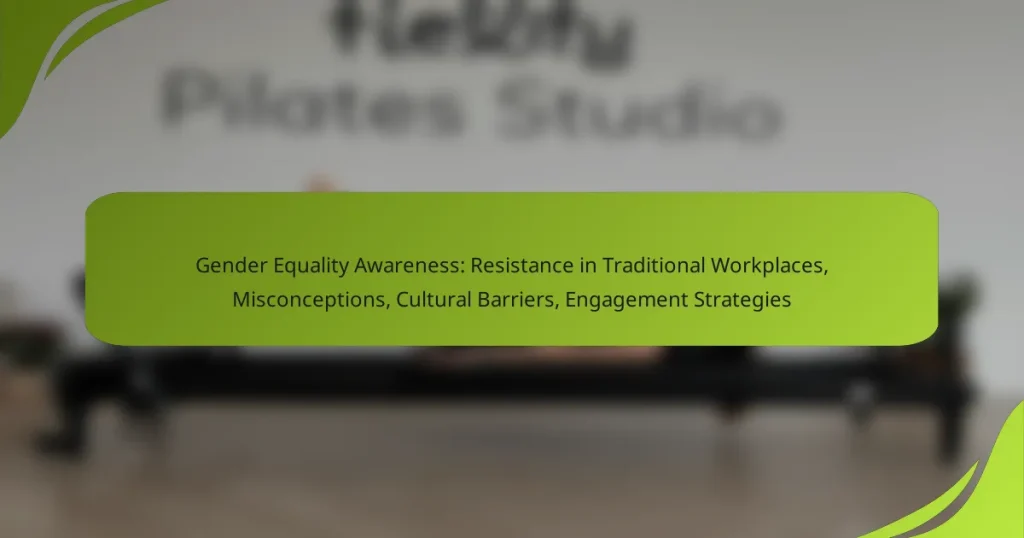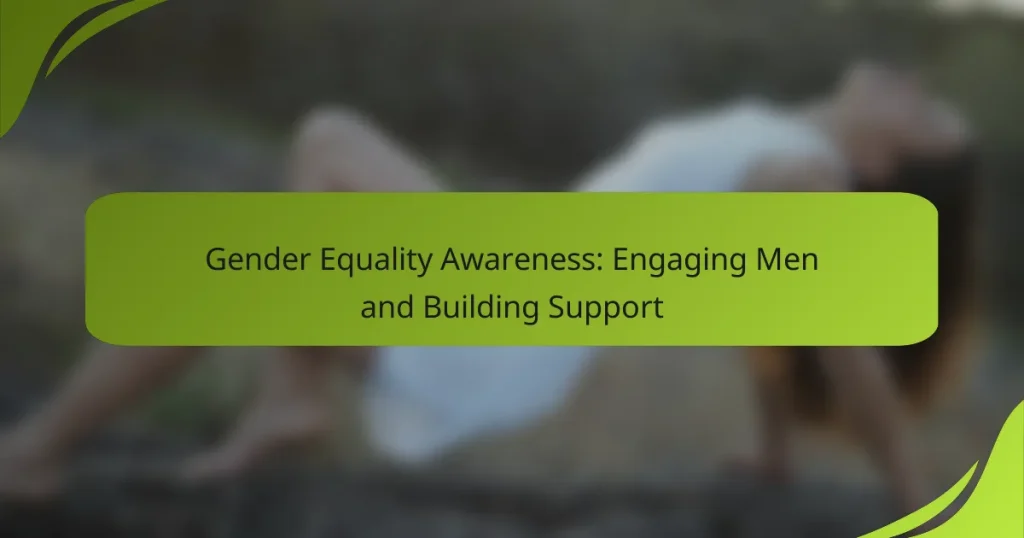Challenges in gender equality programs are multifaceted, encompassing societal norms, insufficient funding, lack of political will, and inadequate data. These barriers can significantly impede the effectiveness of initiatives designed to promote gender equality. To address these issues, strategic initiatives focusing on targeted training, increased funding, and community engagement are essential for fostering a supportive environment and overcoming systemic obstacles.
Gender Equality Awareness: Legal Challenges and Compliance
Gender Equality Awareness: Resistance in Traditional Workplaces, Misconceptions, Cultural Barriers, Engagement Strategies
Gender Equality Awareness: Engaging Men and Building Support
Gender Equality Awareness: Political Climate and Its Impact
Gender Equality Awareness: Misconceptions and Common Challenges
What are the key challenges in gender equality programs?
Key challenges in gender equality programs include societal norms, insufficient funding, lack of political will, and inadequate data. These obstacles can hinder the effectiveness and implementation of initiatives aimed at promoting gender equality.
Societal norms and stereotypes
Societal norms and stereotypes often dictate traditional gender roles, making it difficult for gender equality programs to gain traction. For example, in many cultures, women are expected to prioritize family over career, which can limit their participation in the workforce.
Addressing these ingrained beliefs requires comprehensive education and awareness campaigns that challenge stereotypes. Engaging community leaders and influencers can help shift perceptions and promote more equitable views on gender roles.
Insufficient funding and resources
Many gender equality programs struggle due to insufficient funding and resources, which can limit their reach and effectiveness. Organizations often rely on grants and donations, which can be unpredictable and inadequate for long-term initiatives.
To overcome this challenge, programs should seek diverse funding sources, including partnerships with private sectors and international organizations. Establishing clear budgets and demonstrating the potential impact of gender equality initiatives can also attract more financial support.
Lack of political will
A lack of political will can significantly impede the progress of gender equality programs. When leaders do not prioritize gender issues, necessary policies and legislation may not be enacted or enforced, leaving programs without the support they need.
Advocacy efforts aimed at influencing policymakers are crucial. Building coalitions with other organizations and mobilizing public support can create pressure for political action and commitment to gender equality.
Inadequate data and research
Inadequate data and research can hinder the development and evaluation of gender equality programs. Without reliable statistics, it is challenging to identify disparities, measure progress, or justify funding and resources.
To address this issue, programs should invest in data collection and analysis, utilizing both qualitative and quantitative methods. Collaborating with academic institutions and research organizations can enhance the quality and credibility of the data gathered.
How can organizations overcome these challenges?
Organizations can overcome challenges in gender equality programs by implementing strategic initiatives that focus on targeted training, securing increased funding, and engaging community leaders. These approaches help create a supportive environment that fosters gender equality and addresses systemic barriers.
Implement targeted training programs
Targeted training programs are essential for raising awareness and equipping employees with the skills necessary to promote gender equality. These programs should focus on unconscious bias, inclusive leadership, and effective communication strategies. Regular workshops and seminars can reinforce these concepts and ensure ongoing engagement.
Organizations should tailor training to specific roles and departments, ensuring relevance and practicality. For instance, a tech company might focus on gender representation in STEM fields, while a healthcare organization could address gender disparities in patient care. Evaluating the effectiveness of these programs through feedback and assessments is crucial for continuous improvement.
Increase funding from government and NGOs
Securing increased funding from government bodies and non-governmental organizations (NGOs) is vital for sustaining gender equality initiatives. Organizations should actively seek grants and partnerships that align with their goals. This funding can support training programs, outreach efforts, and research to measure progress.
Applying for funding often requires a clear proposal outlining objectives, expected outcomes, and budget needs. Organizations should also consider collaborating with other entities to pool resources and share best practices, which can enhance the impact of their initiatives.
Engage community leaders for advocacy
Engaging community leaders is a powerful way to advocate for gender equality and mobilize support. Leaders can influence public opinion, drive policy changes, and foster community involvement in gender equality programs. Building relationships with these figures can amplify the message and create a broader support network.
Organizations should identify key community leaders who are passionate about gender issues and invite them to participate in discussions, events, or advisory boards. This collaboration can lead to more effective advocacy efforts and increased visibility for gender equality initiatives within the community.
What role do governments play in gender equality?
Governments play a crucial role in promoting gender equality through legislation, policy development, and resource allocation. Their actions can significantly influence societal norms and provide the necessary framework for advancing women’s rights and opportunities.
Policy formulation and enforcement
Effective policy formulation is essential for establishing a legal framework that supports gender equality. Governments must create laws that address discrimination and promote equal opportunities in various sectors, including employment, education, and healthcare.
Enforcement of these policies is equally important. This involves not only implementing laws but also ensuring compliance through monitoring and penalties for violations. For instance, countries may establish gender equality commissions to oversee the enforcement of these policies.
Funding and resource allocation
Governments are responsible for allocating funds to gender equality programs, which can include initiatives for women’s empowerment, education, and health services. Adequate funding is necessary to ensure these programs are effective and sustainable over time.
Resource allocation should prioritize areas with the greatest need, such as rural communities or marginalized groups. Governments can also partner with NGOs and international organizations to enhance funding and resource distribution for gender equality initiatives.
Monitoring and evaluation of programs
Monitoring and evaluation are vital for assessing the effectiveness of gender equality programs. Governments should establish clear metrics and indicators to measure progress and outcomes, allowing for adjustments as needed.
Regular evaluations can help identify successful strategies and areas needing improvement. For example, feedback from beneficiaries can inform policy adjustments and enhance program effectiveness, ensuring that resources are used efficiently to promote gender equality.
How do cultural factors impact gender equality initiatives?
Cultural factors significantly influence gender equality initiatives by shaping societal norms and expectations. These factors can either facilitate progress or create barriers, depending on the prevailing attitudes towards gender roles and equality.
Influence of traditional gender roles
Traditional gender roles often dictate the expected behaviors and responsibilities of men and women, which can hinder gender equality efforts. For instance, in many cultures, men are viewed as primary breadwinners while women are expected to manage household duties. This division can limit women’s access to education and employment opportunities.
To address these issues, initiatives should focus on challenging and redefining these roles through community engagement and education. Programs that promote shared responsibilities at home and in the workplace can help shift perceptions and encourage more equitable participation.
Resistance to change in patriarchal societies
In patriarchal societies, resistance to change can be a significant obstacle to gender equality initiatives. Deeply ingrained beliefs about male superiority often lead to pushback against policies aimed at empowering women, such as equal pay or reproductive rights.
To effectively navigate this resistance, it is crucial to involve local leaders and influencers who can advocate for change within their communities. Building coalitions that include both men and women can help foster dialogue and gradually shift attitudes towards more equitable practices.
What are successful case studies in gender equality?
Successful case studies in gender equality demonstrate effective strategies and policies that promote equal opportunities for all genders. These examples often highlight systemic changes in political representation and workplace practices that lead to measurable improvements in gender parity.
Rwanda’s political representation
Rwanda has made significant strides in gender equality, particularly in political representation. Following the 1994 genocide, the government implemented a quota system that mandates at least 30% of decision-making positions be held by women. As a result, Rwanda boasts one of the highest percentages of female parliamentarians globally, often exceeding 60%.
This political empowerment has led to the inclusion of women’s perspectives in legislation and policy-making, addressing issues such as health, education, and economic development. The success of Rwanda’s model illustrates how legal frameworks can effectively enhance women’s roles in governance.
Nordic countries’ workplace policies
The Nordic countries, including Sweden, Norway, and Finland, are renowned for their progressive workplace policies that promote gender equality. These nations have implemented comprehensive parental leave systems, allowing both parents to share childcare responsibilities, which encourages a more balanced division of labor at home.
Additionally, policies such as flexible working hours and gender quotas for corporate boards have contributed to higher female participation in the workforce. For instance, Norway’s law requiring at least 40% of board members to be women has led to significant increases in female leadership roles across various sectors.





